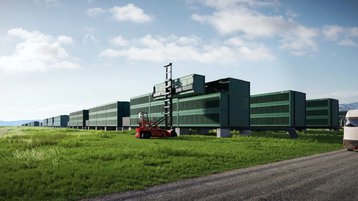Microsoft has agreed to buy "carbon removal credits" from CarbonCapture, a US company that plans to remove carbon directly from the air at a giant facility in Wyoming.
CarbonCapture is installing modular direct air capture (DAC) units the size of shipping containers at its Project Bison facility in Wyoming, which it says will be the largest DAC installation in the world. The credits will be put towards Microsoft's commitment to be carbon negative by 2030 and remove all its historic carbon emissions by 2050. The two companies have not said how much carbon will be removed, given any delivery dates, or said how much Microsoft is paying.
Meanwhile, reports have spelled out that carbon capture is very energy intensive, potentially requiring more energy than that required to power all the world's homes if we are to keep global warming within reasonable limits.
CarbonCapture uses a modular system for carbon capture, similar to that used by ClimeWorks in Iceland, which has also had funding from Microsoft to remove 10,000 tons of carbon over a decade.
CarbonCapture plans to open its Project Bison facility in an undisclosed location in Wyoming in 2024, starting with around 20 containers that can capture 10,000 tonnes of carbon per year, and ramping up to five million tonnes by 2030, chief commercial officer Jonas Lee told DCD over Zoom.
"We are focused on the US completely," said Lee. "This is where the opportunity is for the next decade. It doesn't make economic sense to go anywhere else."
While Iceland offers plentiful renewable power, it is only a small country, said Lee. The US now has an investment strategy for carbon capture under the Biden administration, with the Bipartisan Infrastructure Law providing $3.5 billion for carbon capture, and other measures in the Inflation Reduction Act (IRA) adding up to a subsidy of $180m for capture and storage of a tonne of carbon.
CarbonCapture's "reactor" modules draw carbon out of the air into filters. When they are saturated, they are heated up to release the carbon so it can be extracted in a permanent form and can be pumped deep underground into saline aquifers for permanent storage. CarbonCapture and its partner, Texas-based Frontier Carbon Solutions, are working to get a Class VI well, the only authorized place to store carbon in the US.
"The well is the gating item," explained Lee. "It's heavily regulated, and rightly so, as it is critical that these wells work. You have got to make sure storage is permanent, with no seismic risk There are only a handful of Class VI wells in the US today, but dozens more are in line to be approved over the next several years.
Each well has a huge capacity, and can take 250,000 to a million tonnes of carbon per year, he explained.
According to UN reports, the world needs to collectively remove six to ten 10 billion tons (10Gton) of carbon dioxide per year by 2050 in order to remain on a path to limiting global warming to 1.5°C.
Estimates for the energy requirement vary, but it will be huge and has been estimated to be more than the world currently uses for all household energy. Currently, it takes around 1200kWh (1.2MWh) to remove a tonne of CO2, and this is not expected to fall below a minimum of 250kWh. Removing 10Gton of CO2 at a cost of 1Mwh per tonne would need a total of 10 billion MWh.

